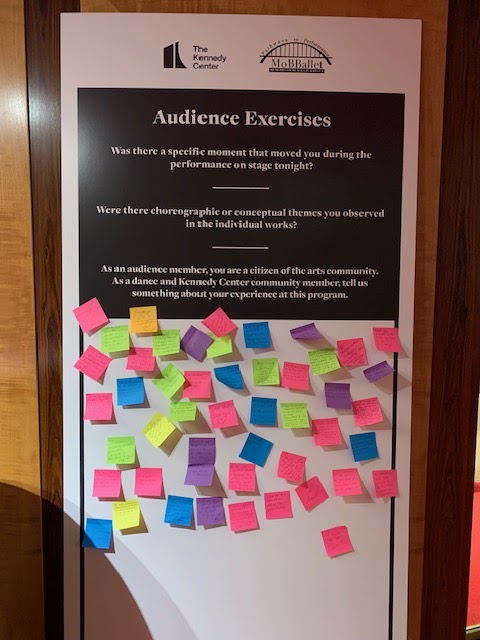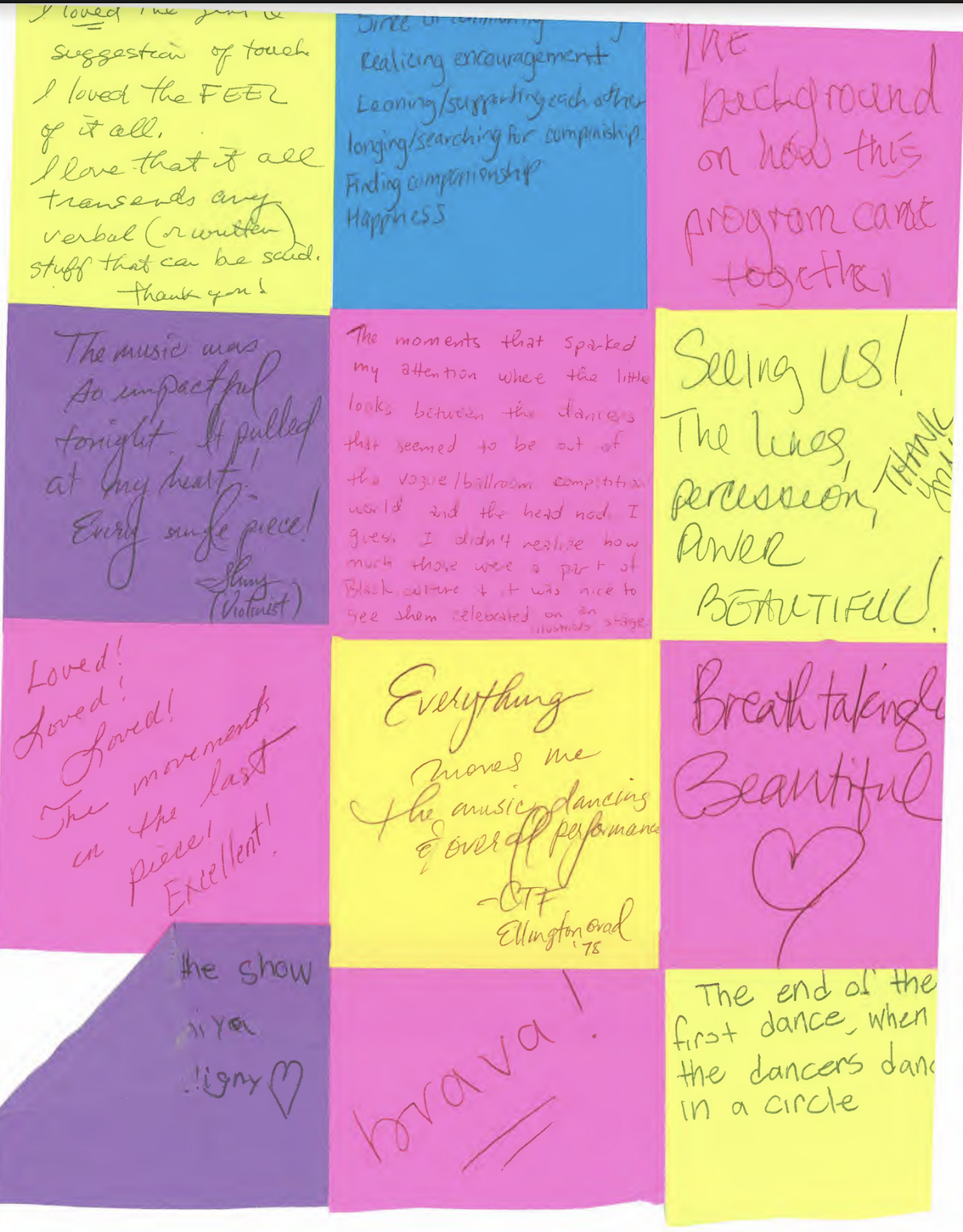CURATING IN THE ROUND By Theresa Ruth Howard

Attendee Affiliated Publications: The New York Times, San Francisco Chronicle, Seattle Times, Boston Globe, LA Dance Chronicle, Fjord Review, thINKingDANCE, Pointe Magazine/DanceMedia, Dance Magazine, The Brooklyn Rail, Danspace Journal, Culturebot, The AMP and personal Substacks. Members of our cohort included professors at Barnard College, CalArts, and, Black Dance Stories, Brooklyn Academy of Music.
Learn more about the MoBBallet Dance Writers Conference and read reflections
CURATING IN THE ROUND
By Theresa Ruth Howard
Nigerian novelist Chinua Achebe wrote in his debut work Things Fall Apart (1958) –“Until the lion learns how to write, every story will glorify the hunter.” The recounting of history is never neutral. The recounter has a point of view which influences their interpretation and presentation of the facts. Keeping with the Nigerian writer theme, in Chimamanda Ngozi Adichie’s 2009 TED Talk, “The Danger of the Single Story,” she reminds us that the point in which you start a story, and the tellers point of entry and position, determine the villain and heroes of that story.
Curators are storytellers, drafting narratives, like a good griot, (or magicians) they draw your attention to what they want you to see with emphasis or amplification. Their carefully constructed worlds draw you in while imbedding seedlings of information and opinion. Curators draft narratives to support their interpretations, facts which can be redacted, elasticized, warped or polished on one side to support their angle.
In addition to being the founder of the digital archive MoBBallet (Memoirs of Blacks in Ballet) I also act as curator. I consider myself a custodian of the information, and create the virtual installations that are a key component of our content. Additionally I thought it important to acknowledge that the information, and its presentation represented a value system, lens and vision. Never in my wildest dream would I have imagined that I would be tapped for what seemed to be a once in a lifetime opportunity. On January 16, 2021 I received an email with the heading INVITATION TO GUEST CURATE from Rabinovitz, Jane K at Kennedy-Center.org. It started:
“I am reaching out today to see if you might be interested in having a conversation with me about possibly guest curating a program for our 21-22 ballet season.”
The invitation was for myself and then President and CEO of the International Association of Blacks in Dance (IABD) to co-curate a week long festival dedicated to Blacks in Ballet.When looking for an appropriate title for a program celebrating Blacks in Ballet, Reframing the Narrative was the only thing that made sense.
This invitation to curate a program for the Opera House in the Nation’s Cultural Center was the largest platform I might ever be afforded. Reframing the Narrative needed to be more than your average ephemeral dance performance, the memories of which begin to fade as the curtain descends. If we were going to “Reframe” the narrative, we first had to name and define it, then offer another perspective through education. This was an opportunity to shift hearts and minds and I knew exactly what I wanted, neé needed to do. Jane Rabinovitz Raleigh and the Dance Programming team were our enthusiastic co-conspirators as unconventional elasticity was injected into the role of “curator”. Personally I give every opportunity stretch marks.
MoBBallet and my work as a consultant and Diversity Strategist takes a °360 approach to address the entirety of the ecosystem. Focusing on one area will not create sustainable change. My artistic lineage stems from Arthur Mitchell and his Dance Theatre of Harlem which used dance as activism and social justice. My design, facilitation and curation philosophy focuses not only on the epicenter but the possibilities within the cascading effect on the community beyond the original touch point.
I call this approach curating which involves a °360 crafting of the audience experience including pre- performance from: the marketing tools, (verbiage, and space of distributed), enrollment (engaging and activating communities, personal and professional networks and spheres of influence) interactive and static education (i.e.masterclasses, panels, interviews, articles, workshops), ticketing incentives (reimagining pricing, creating a scale of affordability which creates accessibility to broader communities) and finally providing an interactive immersive experience in the theater. This full sensory, interactive, inclusive environment creates an experience, helps to eradicate the intimidation factor, welcomes people in and makes the theater feel familiar.
In the case of Reframing, my contribution was the Residency (Choreographer Donald Byrd created From Other Suns on 11 international Black identifying Ballet dancers who danced in historically white companies). During the two-week residency we held masterclasses for local students. We showed that the depth of the legacy of Blackness in Ballet went beyond what was presented on stage. Using the MoBBallet Archives, I transformed the Center’s Campus into a learning tool by creating an immersive experience (which I likened to a theme park) that invited the audience to interact with the history. Windmasters set around campus with historical data points, the MoBBallet Ballet Constellations and a virtual history quiz game (all with QRs to full webpages) were installed in the lobby, vitrine and River Plaza kept the audience engaged during intermission.
Curating in the round allowed the Kennedy Center’s Dance Programming to become an agent of social impact, and have an authentic impact on the well-being of the community through art, education, and shifting the environment. This process also had internal impact as it revealed the broader possibilities to Raleigh who was a first-year director. She was able to see neé experience the impact first hand as she was religiously in the lobby (in her power suit) engaging with patrons and listening to feedback. Afterwards we had numerous conversations about how to continue this exploration of how the Kennedy Center (as a presenting body) could support the changing dance landscape.
Two years later, MoBBallet’s Pathways to Performance: Exercises in Reframing the Narrative made its debut in the Eisenhower Theater July 2-3rd, 2024. The ‘exercise’ was in exploring the social impact of curating in the round. The program featured five Black Ballet Choreographers: Portia Adams (Pathways Fellow), Jennifer Archibald, Donald Byrd, Meredith Rainey (Pathways Fellow), and Kiyon Ross again with a cast of Black ballet dancers. We: engaged local Black ballet teachers to give company class, and held conversations, workshops with local dance educators, and once again held masterclasses taught by our artists. This time, we went bigger, folding in yet another aspect of the dance ecosystem, dance writers.
The MoBBallet Dance Writers Conference: Examining the Role, Responsibility and Relevance in the Evolving Ecosystem of the Field was held June 30–July 2nd in Center’s REACH campus, and was supported by Critical Minded, an initiative to invest in cultural critics of Color co-founded by The Nathan Cummings Foundation and The Ford Foundation. The convening invited dance writers and editors into an dialogic, investigative process to interrogate the role and responsibility of dance writers within an ecosystem that is rapidly changing, as well as their relevance to that industry as staff-writing positions are eradicated, social media influencers hold maximum sway, and low writing fees make it impossible to make a living. Being that the Washington Post axed its dance critic position in 2022, made the Kennedy Center (a presenter of dance) the apropos place for this gathering.
When designing a convening such as this, the goal is never to solve all of the problems, rather it is to identify the issues and establish a baseline, educate, enroll, and empower. We had 12 writers who represented the spectrum of diversity (age, race, ethnicity, gender identity and publications) discussing the widening of the field and interrogating the presence of implicit bias in dance criticism and journalism. Conversations on Impact with Choreographers and Presenters, brought choreographers Byrd and Archibald along with presenters Pamela Tatge (Executive and Artistic Director of Jacob’s Pillow) and Raleigh into the conversation (read more about the The MoBBallet Dance Writers Conference and the writers reflections HERE.) The writers were also invited to the Pathways performance where the audience members participated in the exercise by offering their own impressions of the work on post-its in the lobby.
By curating in the round, we were able to establish that when arts presentation are designed with the full spectrum of humanity in mind it results in a more fulsome experience. The power and impact resonate far beyond the original touch point. By expanding the experience of art, you can truly put it into people’s lives through experiential embodiment.
My personal mission is to draft a new blueprint for ballet and beyond by creating models within the field that are fully transferable to other sectors. By expanding the ways and boundaries audiences traditionally engage with art—even at times inviting them to become active participants—it is possible to truly incorporate art into people’s lives through experiential embodiment. As a curator, I see this as our role and responsibility to maintain relevance of the form, as well as the health of the ecosystem while pushing boundaries, making space and inviting people in. I feel fortunate that my experience curating at the Kennedy Center has allowed me to produce the fullest version of my vision and that we are on a journey together to test the elasticity of what is possible for the field and for audiences. Watch the space!


